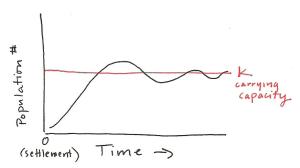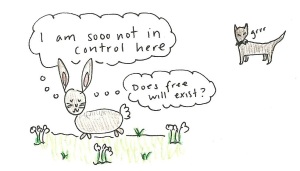Population Ecology: The Basics
Population ecology is the study of the dynamics of populations in an ecosystem. It asks the questions: how does a population of organisms change over time? How does this change affect other populations? How do other populations affect this one? I’ll be using the example of rabbits to illustrate the basic terms and ideas used in this field.
So we have our population of rabbits, described as a flat number of individuals or alternatively in terms of density. This population of rabbits doesn’t exist all on its own, but is part of a larger community which controls its ability to grow or shrink. There are 2 types of controls on a population: bottom-up control, which is the limitation placed by resources allowing growth such as food source, habitat, or space, and top-down control, which is the limitation placed by factors controlling death such as predation, disease, or natural disasters.
Let’s look at bottom-up controls first, using the food source of clover as an example. In a world of limitless clover, the rabbits should be able to reproduce and expand their population exponentially. But, of course, there will be years with clover abundance, and years with clover famine. Thus clover is able to set the maximum limit of a population at any given time. The number of rabbits that the clover is able to support is called the carrying capacity of the ecosystem: the population size that can be supported by available resources.
You can probably imagine a scenario where the rabbit population could grow rapidly in size and consume clover to the point that this resource is destroyed, forcing this rabbit population to migrate or else die. This sort of rampant overexploitation of resources is usually halted by a top-down control, such as a predator. When the rabbit population is small, predators are less likely to pay attention to them due to their relative secrecy. But as the population gets larger, they not only draw more attention to themselves, but the energetic benefit for coyotes to target rabbits specifically increases. Thus, predators (or disease, natural disasters) provide a check on the rabbit population.

Standard figure describing carrying capacity, the number of individuals of a population that the environment can support. The population line tends to waver around the carrying capacity due to variation in resources and external death. Drawn by Hannah Waters
Populations tend to never exist at their precise carrying capacity, but rather undulate above and below it. When the population gets too large, the predators drive it back down. But the resulting decrease in their prey reduces the predator population, allowing the prey to bounce back. This is illustrated in the figure above.
As a result, the bottom-up and top-down controls tend to regulate a stable population at the carrying capacity of the ecosystem. The bottom-up resources set the limit for the maximum healthy population, and the top-down forces kill off individuals from a large population, preventing overexploitation.
This idea that populations interact and regulate one another is a primary argument for conserving wildlife.
I did my best to explain this in plain english. If you are confused or can point out a section that could use clarification, please send me an email at hannah.waters [at] gmail.com.







[…] Skip to content HomeAboutAwards and MentionsPhilly Science EventsPrimersDNA BasicsPopulation Ecology: The BasicsProtein Synthesis BasicsWorks CitedCulturing Science – Index by AuthorCulturing […]
The Allee effect in action: why endangered Vancouver Island marmots are struggling to recover | Culturing Science – biology as relevant to us earthly beings
October 20, 2010 at 1:32 pm